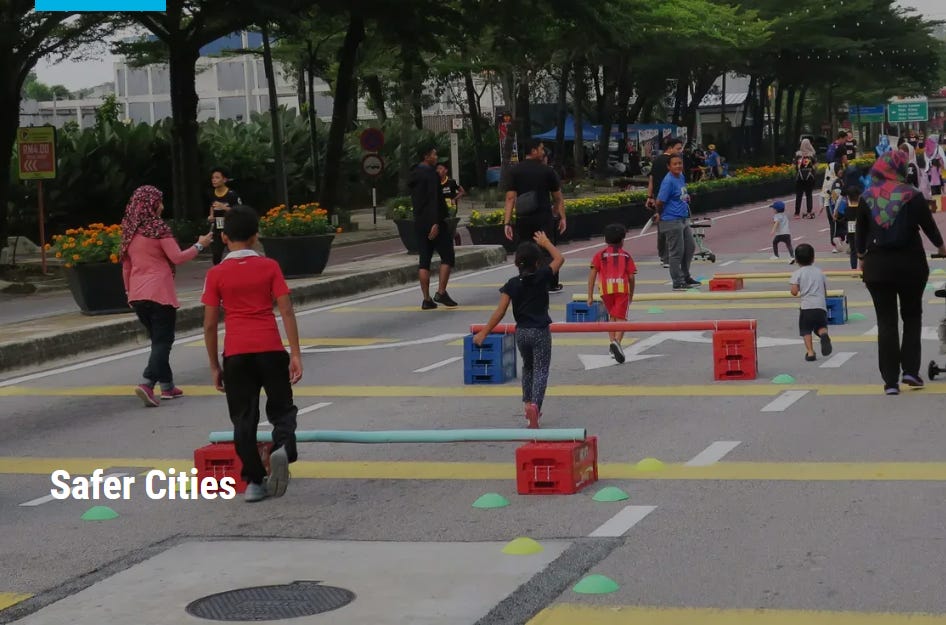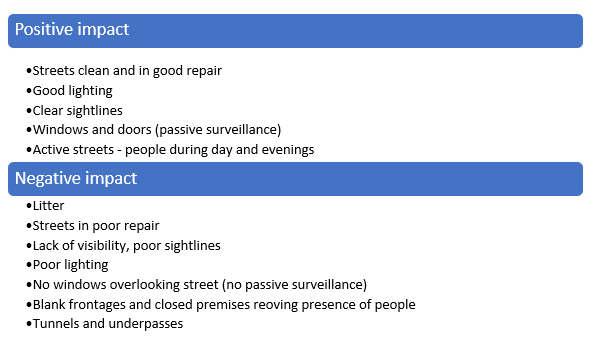Safer Places, Passive Surveillance and Placemaking | Policies for Places
Safety is a vital ingredient of a successful place, yet stories in the media of violence and harassment in city streets and other ‘third places’ are everywhere. How should towns and cities respond? In this piece I want first to explore the idea of a safe place a little and outline broad perspectives which commonly underpin responses to promote place safety. Second, I set out some measures which are commonly taken relating to each perspective, and then third I will try to relate the implications of all this for the lived experience of cities and neighborhoods.

What is a safe place?
A safe place is a space or an environment in which an individual or a category of people can feel confident that they will not be exposed to discrimination, harassment or any other emotional or physical harm. It should be free of conflict or potentially threatening actions.
Safe places are often thought of in terms of refuges, shelters or sanctuaries to which people under particular stress from such issues as domestic abuse, homelessness or mental health issues can turn for support or to assess assistance open to them in a calm and non-threatening atmosphere.
My concern here however is with cities and towns, neighborhoods and streets which comprise the environment in which people live and experience their daily lives. Safe cities can be defined in terms of a range of indicators such as levels of crime, accidents, digital security, management of natural disasters and quality of infrastructure as well as personal safety (see for example, the Safe Cities Index developed by the Economist’s Intelligence Unit). League tables of ‘safest cities’ are published regularly based on a range of such indicators.
It is increasingly clear however that safety is not just about the probability of becoming a victim of crime. As well as these statistical measures, it is increasingly understood that individual perceptions of personal safety also provide a valid way of understanding the lived experience of safety in cities and neighborhoods. Planning issues such as traffic management and pedestrian safety, walkability and safe public transport will contribute to resident’s perceptions of safety and consequent behaviour. Specific groups in the population such as women will have particular concerns about their safety on city streets and public spaces and look for design features which provide clear sight lines and encourage busy streets and well-used public facilities.
Risks to place safety
Writing about place safety consistently highlights a range of risks which relate to cities as a whole, to features of urban infrastructure, to users of public places and to local environments. Cities will, for example, wish to keep their major civic buildings, business districts and cultural assets safe from attack from terrorists, cyber-attacks or other hostile or criminal groups. Cities will want to have efficient public transportation which people feel confident to use. Cities will want to minimise the risks to pedestrians from road traffic. Cities will want to ensure that public places are not only accessible and attractive but are also safe places for users to meet and interact. Cities will want to encourage people to feel safe as they go about their daily lives in their local streets.
Safety risks vary in scale and in character and will impinge on the lived experience of residents and other stakeholders in different ways.
It is clear for example that women experience cities very differently from men. Surveys consistently show large proportions of women feel unsafe walking in their neighborhoods at night to the extent that some decide not to go out at all in the evenings or after dark. Similarly gender is the most significant factor in how anxious people feel when using public transport. Public toilets remain disproportionately available for men, and women and girls face risks of attack through poor and poorly designed facilities.
People with disabilities, from minority ethnic groups and sexual minorities, the homeless and those of lower socio-economic status are also at higher risk of attack and harassment as they go about in city streets and public spaces. The extent of unease is clear from the findings on perceptions of personal safety and experiences of harassment in the most recent Opinions and Lifestyle Survey in the UK which found for example, that 1 in 2 women and 1 in 5 men felt unsafe walking alone after dark in a busy public place, disabled people felt less safe walking alone in all settings than non-disabled people, and 3 out 5 women aged 16 – 34 experienced at least one form of harassment in the previous 12 months. Importantly 6 out of 10 people who reported feeling unsafe during the day and 4 out of 10 who reported feeling unsafe after dark had altered their behaviour as a result.
Businesses and cultural venues need security to prevent damage, disruption and access, but also recognize that perceived limitations to place safety in their locations is to the detriment of their success.
Responses
Two broad perspectives seem to dominate efforts to promote safer places. These can be characterized as first, safety as security and control, and second, as safety as a component of lived experience and placemaking. The first emphasizes materiality of places and crime prevention through securing environments such as city streets, shopping malls and public spaces. The second puts more emphasis on social dimensions arising from understandings of the perceptions of stakeholders. As we have seen, perceptions of safety are socially produced. It is not simply the presence of crime that leads to a lack of safety or to fear.
Safety as security and control
Security measures aim to establish a safe urban environment both by preventing damage, disruption and criminal activity and also providing the means to help identify perpetrators. Such measures will likely include high visibility policing, permeable barriers, plentiful CCTV and other digital data. It is also likely to include controversial policing methods such as stop and search if police have reason to suspect potential criminal action or risk of disorder.
Whilst such measures as these can be effective deterrents and provide vital information about people movement and behaviour, too much of it can in itself be oppressive. Without taking account of the social dimensions of safety, these measures designed to enhance safety may have the opposite effect on some social groups.
Safety as a component of placemaking
Another school of thought has it that safety in public places can be enhanced through environmental design. Streets are one of the most important public places each community has. The richness and quality of street life can be enhanced by now well-documented processes of placemaking, a collaborative process in which communities contribute to the design of streets which contributes to access, attractiveness people’s health and wellbeing. The so-called ‘broken windows’ theory of crime has echoes in perceptions of public safety in urban localities.
Studies regularly point to a series of features of public places which are associated with people feeling safer – or less safe. These are summarized below.

Active or passive surveillance
It was Jane Jacobs who emphasized the importance of ‘eyes on the street’ to understand social life in a neighborhood. More’ eyes on the street’ also offers the opportunity for passive surveillance which is associated with reduced crime and makes a place more welcoming. Passive surveillance is a function both of the design of the street itself and of the way buildings are designed and used. Places with people – even in traffic on busy roads – can have a direct impact on how safe places feel.
The safety through security and control approach might be referred to as active or purposive surveillance. The safety through placemaking approach relies, on the other hand, on creating opportunities for maximizing passive surveillance from those in the streets and from the windows and doors which overlook it.
The task of revitalizing and repositioning city and town centres struggling with sinking levels of attractiveness through relocation of housing and shopping, and the consequent rising perceptions of unsafety offer a particular challenge for urban planners. Designs which seek to encourage streets as places to go to rather than just through will sustain passive surveillance and contribute to neighborhood recovery through improved perceptions of public safety..
So we need to understand safe places as enacted and lived, and shift from regarding safety as a measure of control to safety as a component of everyday placemaking.
Nobody wants to live in a police state, so we need to avoid security measures which are in themselves threatening. Whilst place safety requires reduced crime, but it also requires things like improving safety of public transport. The delivery of other policy goals such improved sustainability requires designs for more walkability, more distinct bike lanes and reduced traffic for better pedestrian safety. An inclusive approach to the safety of places needs an audit of neighborhood risks which takes account of the different lived experiences of safety of different social groups. Ultimately there is no city safety agenda without a social equality agenda alongside.
 Printer-friendly version
Printer-friendly version- Login to post comments





